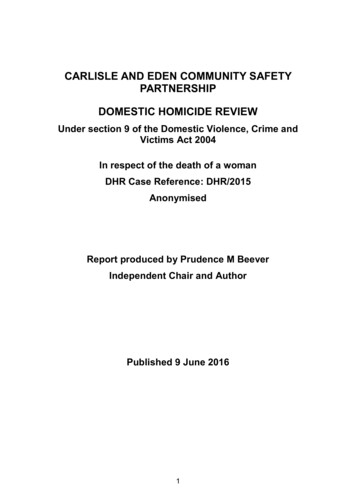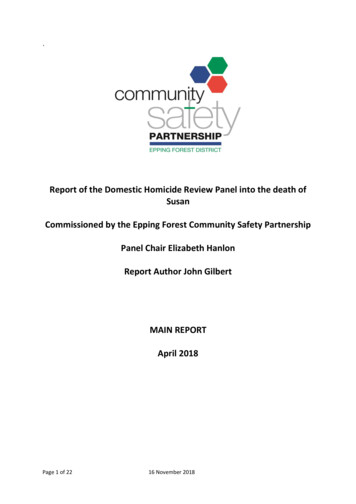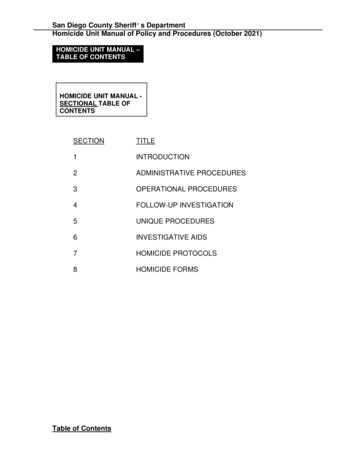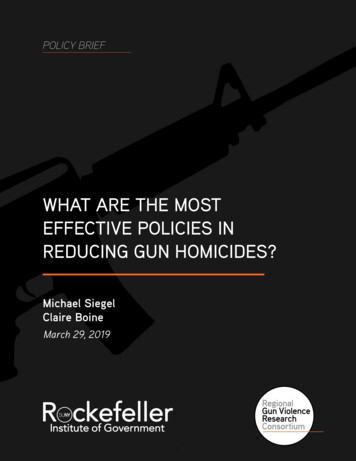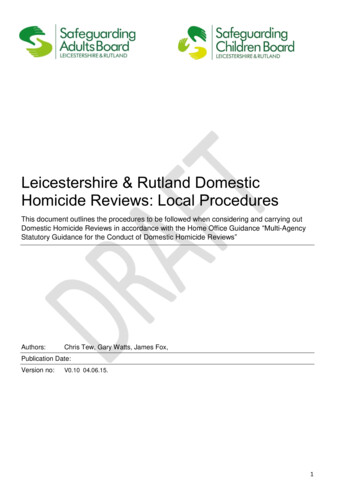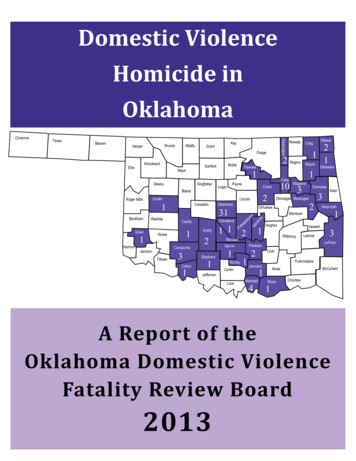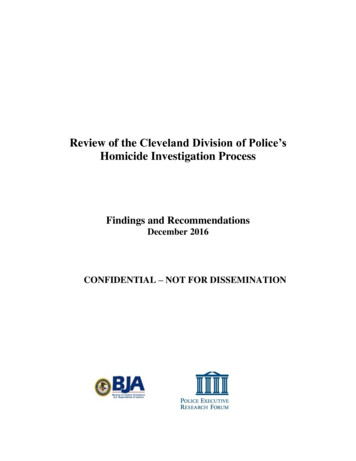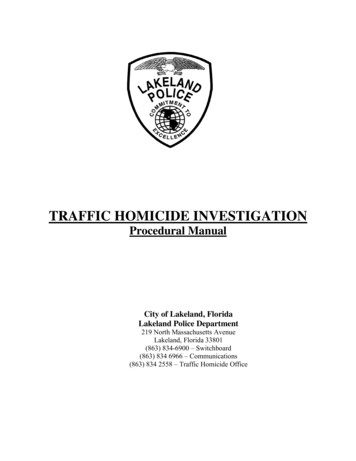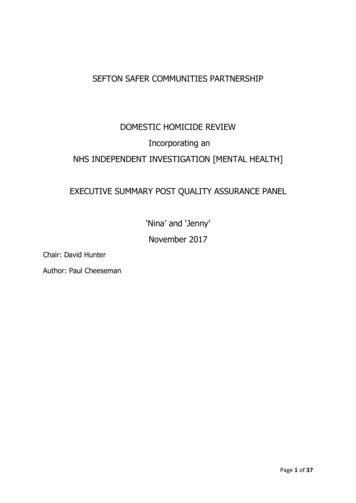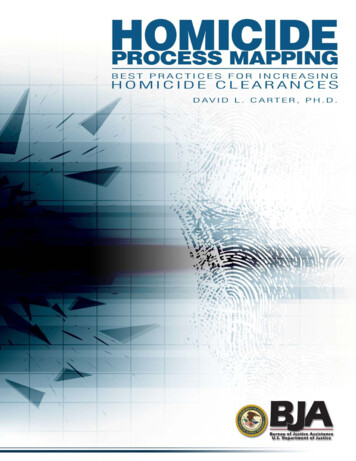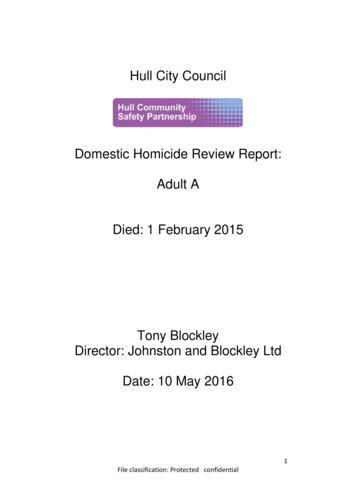
Transcription
Hull City CouncilDomestic Homicide Review Report:Adult ADied: 1 February 2015Tony BlockleyDirector: Johnston and Blockley LtdDate: 10 May 20161File classification: Protected confidential
Subject12PageIntroduction3Preface3The circumstances that led to the Domestic Homicide Review3Scope of the review4Terms of reference5Methodology7Panel9Family involvement (Genogram)10Information from work colleagues and friends1011What agencies knew prior to Adult A’s deathAdult A11Adult B113Chronology of events114Analysis of involvement285Humberside Police29Hull and East Yorkshire Hospitals NHS Trust (HEY)29GP Practice, including drugs link worker30ReNew Community30Corner House30Humber NHS Foundation Trust31Together Women Project3131Addressing the terms of referenceLessons learned376Conclusions377Recommendations382File classification: Protected confidential
1IntroductionPreface1.1The city and port of Kingston-Upon-Hull lies on the banks of the river Humber andis positioned at the gateway to Europe. It is linked to the national motorwaynetworks from the west via the M62 and to the south across the Humber Bridgevia the M180. The city of Hull covers a relatively compact area of 74 km2.1.2Kingston-Upon-Hull is surrounded by the East Riding of Yorkshire a largely ruralarea but which contains a number of suburbs immediately adjacent to the city.The population of Hull in mid 2014 was estimated to be 257,700, the highest ithas been since 1998, but smaller than the overall population of the surroundingEast Riding, which was estimated to be 337,100. The ONS 2011 Censushousehold count for Hull was 112,596, approximately 5% of the total number ofhouseholds in the Yorkshire and the Humber region. The land registry householdcount for Hull in 2015 was 118,220.1.3Kingston-Upon-Hull consists of 23 wards, containing 166 lower super outputareas and 853 output areas, the lowest geographical level for which Census datais measured. There are 3 parliamentary constituencies in the city, East Hull,West Hull and North Hull, each returning one elected Member of Parliament.1.4The circumstances that led to this Domestic Homicide Review1.5This Domestic Homicide Review (DHR) Overview Report is about Adult A, a 51 year-old woman, who died in Hull, Humberside, on 1st February 2015. Herpartner, Adult B murdered her.1.6On 8th June 2015, Adult B appeared at Kingston-Upon-Hull Crown Court andpleaded guilty to manslaughter on the grounds of diminished responsibility. Hewas nevertheless tried for murder and was found guilty. He was sentenced to lifeimprisonment with a recommendation that he must serve 22 years before beingeligible for parole.1.7In his sentencing comments, the trial Judge said that Adult B had carried out themurder “With brutal determination” and added that “ having killed her you lefther body in that hotel room and made your departure that was callous”. Whenpassing sentence, the Judge said, “It is my view at present that you pose suchdangers that I cannot envisage a time when it will be safe to release you”.1.8Adults A and B had been in a long-term relationship. Adult A had a child (Adult C)from a previous relationship and they (Adult A and Adult B) had another child(Adult D) together. Adult C was (31 years old) at the time of Adult A’s death andAdult D (27 years old).1.9Prior to the murder, Adult B had been violent and abusive towards Adult A onseveral occasions. They had recently separated and on 31st January 2015, thetwo had met for a meal at a local pub, just outside Kingston-upon-Hull city centreto discuss reconciliation.3File classification: Protected confidential
1.10After the meal they booked a room in a hotel in Hull. About two hours later, AdultB left the hotel, clutching the side of his face. He had just murdered Adult A bystabbing and strangling her.1.11The following day, hotel staff found Adult A’s body in the bedroom and theynotified the police. Adult B was arrested later that day in York.1.12Following agreed protocols, on 5th February 2015, Humberside Police notifiedHull Community Safety Partnership (CSP) of the circumstances of Adult A’sdeath. On 5th March 2015, the Domestic Homicide Review Multi-Agency CoreGroup meeting decided that a Domestic Homicide Review should be conductedin accordance with section 9 of the Domestic Violence, Crime and Victims Act(2004) because it was clear that a person to whom she had been related or withwhom she was or had been in an intimate personal relationship had caused AdultA’s death.At that time the meeting did not feel there was sufficient information available toformulate specific terms of reference for the review.1.13A decision was made to postpone the review pending the outcome of any criminalproceedings that may follow.1.14On 5th March 2015 agencies were asked to review their records to determinewhether they had been involved with Adult A and / or Adult B in the past, and toseal any records they may have had.1.15On 17th March 2015, the Home Office was notified of the intention to carry out aDomestic Homicide Review.The completion of the review has been delayed in an attempt to engage with thefamily of Adult A. This was considered important to provide backgroundinformation relating to the relationship between Adult A and Adult B. As thereview progressed two further agencies were identified and it was determinedthey may hold important information and therefore they were asked to participate.1.16Scope of the Review1.17It is believed that Adult A and Adult B had met 30 years ago. At that time Adult Awas working as a sex worker and Adult B went with her to London.1.18There had been previous agency involvement with Adult A and with Adult B andconsequently the dates of the review were set between 1st February 2012 and thedate of Adult A’s death 1st February 2015. February 2012 was chosen as thecommencement date due to the fact that agencies had started to engage withAdult A and Adult B at this time.1.19If there was any other information outside those dates that agencies felt wasrelevant, they were asked to include it.4File classification: Protected confidential
1.20Terms of Reference1.21The purpose of the review was to: Establish what lessons could be learned from the domestic homicide aboutthe way in which local professionals and organisations work individuallyand together to safeguard victims of domestic abuse Clearly identify what those lessons are both within and between agencies,how and within what timescales they will be acted upon, and what isexpected to change as a result Apply those lessons to service responses and include any appropriatechanges to policies and procedures Prevent future domestic homicides through the improvement of serviceresponses for all victims of domestic abuse, and their children, throughimproved intra or inter-agency working.The review aimed to address: Whether the incident in which Adult A died was a ‘one off’ or whether therewere any warning signs and whether more could be done to raiseawareness of services available to victims of domestic abuse. Whether there were any barriers experienced by Adult A or her family,friends and colleagues in reporting any abuse in Hull or elsewhere,including whether they knew how to report domestic abuse should theyhave wanted to. Whether Adult A had experienced abuse in previous relationships in Hullor elsewhere, and whether this experience impacted on her likelihood ofseeking support in the months before she died. Whether there were opportunities for professionals to ‘routinely enquire’ asto any domestic abuse experienced by Adult A that were missed. Whether Adult B had any previous history of abusive behaviour to anintimate partner and whether this was known to any agencies. Whether there were opportunities for agency intervention in relation todomestic abuse regarding Adult A or Adult B that were missed. The review should identify any training or awareness raising requirementsthat are necessary to ensure a greater knowledge and understanding ofdomestic abuse processes and / or services in the area covered by theHull Community Safety Partnership. The review will also give appropriate consideration to any equality and5File classification: Protected confidential
diversity issues that appear pertinent to Adult A and Adult B and anydependent children e.g. age, disability, gender reassignment, marriageand civil partnership, pregnancy and maternity, race, religion and belief,sex and sexual orientation.1.22The overall rationale for a review is to ensure that agencies are respondingappropriately to victims of domestic abuse by offering and putting in placeappropriate support mechanisms, procedures, resources and interventions withthe aim of avoiding future incidents of domestic homicide.The review identified the following general areas for consideration:1.231.241.25Family and Friends engagement How should friends, family members and other support networks and,where appropriate, Adult B, contribute to the review and who should beresponsible for facilitating their involvement? How matters concerning family and friends, the public and media shouldbe managed before, during and after the review and who should takeresponsibility for it.Legal Processes How will the review take account of a coroner’s inquiry, and (if relevant)any criminal investigation related to the homicide, including disclosureissues, to ensure that relevant information can be shared without incurringsignificant delay in the review process or compromise to the judicialprocess? Does the review panel need to obtain independent legal advice about anyaspect of the proposed review?Research How should the review process take account of previous lessons learnedfrom research and previous Domestic Homicide Reviews?In order to reach a view on whether Adult A’s death could have been predictedand/or prevented, the Individual Management Review (IMR) authors were askedto include information on, and analysis of, all the following issues:1.26Diversity Are there any specific considerations around equality and diversity issues,such as ethnicity, age and disability that may require specialconsideration.6File classification: Protected confidential
1.271.28Individual Agency Responsibility Was the work undertaken consistent with the organisation’s policies andprocedures for safeguarding and promoting the welfare of adults and withwider professional standards? What were the key relevant points/opportunities for assessment anddecision making in relation to Adult A and Adult B. What was the quality of any multi-agency assessments? Was the impact of domestic abuse on Adult A recognised? Did actions accord with assessments and decisions made? Wereappropriate services offered / provided or relevant enquiries made, in thelight of assessments? Was there sufficient management accountability for decision-making?Were senior managers or other organisations and professionals involvedwhere they should have been?Issues which relate to ethnicity, disability or faith which may have a bearingon this reviewCultural issues relating to the reporting of domestic abuse were identifiedand are subject of discussion within the report.1.29Other Domestic Homicide Reviews in the region or nationally which aresimilar, and the availability of relevant research(None have been identified at the time of writing).1.30Methodology1.31This overview report has been compiled from analysis of the information suppliedin the agency IMRs, open source material, previous Domestic Homicide Reviewreports and research into various aspects of domestic abuse.1.32The following documents have also been referred to: The Home Office Multi-Agency Statutory Guidance for the conduct ofDomestic Homicide Reviews (Home Office June 2013)The Home Office Domestic Homicide Review Tool Kit Guide for OverviewReport Writers (Home Office March 2012)Call an End to Violence Against Women and Girls (HM Government March2016)Barriers to Disclosure (Walby and Allen, 2004)Home Office Domestic Homicide Reviews – Common themes identifiedand lessons learned (November 2013).7File classification: Protected confidential
Prevalence of intimate partner violence: findings from the WHO multicountry study on women's health and domestic violence, (2006).‘If only we’d known’: an exploratory study of seven intimate partnerhomicides in Engleshire (July 2007)1.33Participating Agencies1.34The following agencies were asked to provide chronological accounts of theircontact with Adult A and with Adult B. Humberside PoliceHull Domestic Abuse Partnership – Domestic Abuse Support ServiceHull City Council HousingNational Probation ServiceReNew CommunityCorner HousePreston Road Women’s CentreHumber NHS Foundation TrustGeneral Practitioner, including drug links workerHull and East Yorkshire Hospitals NHS TrustAs the review progressed it was identified that the Together Women’s Project hadbeen involved with Adult A and they were asked to provide a summary of theirinvolvement.1.35Each agency was required to report the following: A chronology of interaction with Adult A and / or Adult BWhat action was taken and to provide an analysis of those actionsWhether internal procedures were followed and if those procedures wereappropriate in light of the death of Adult AConclusions and recommendations1.36Domestic Homicide Review Panel Chair / Overview Report Author1.37Following the Domestic Homicide Review Core Group meeting on the 5th March2015 it was decided that Johnston and Blockley Ltd would be approached to actas Independent Chair and Author for the review.1.38One of its partners, Mr. Tony Blockley, undertook the task. He is a specialistindependent consultant in the field of homicide investigation and review. He hassenior management experience in all aspects of public protection. He has beeninvolved in numerous homicide reviews throughout the UK and abroad, was chairof MAPPA and was responsible for all public protection issues when he was headof crime in a UK police force. He has been involved in several DHRs and seriouscase reviews. He is also a special advisor to a 3rd sector organisation thatprovides domestic abuse services (not in the area covered by the HullCommunity Safety Partnership) and is a Senior lecturer in criminology at theUniversity of Derby.8File classification: Protected confidential
1.39The Domestic Homicide Review (DHR) Panel1.40The DHR Panel on behalf of Hull Community Safety Partnership agreed theformation of the overview panel comprising of agencies that had contact withAdult A and Adult B during the period under review, and some others, including arepresentative from a specialist domestic abuse service.1.41The DHR Review Panel consists of:1.42NameOrganisationTony BlockleyIndependent Chair and Overview AuthorVicki PaddisonHull Community Safety PartnershipDawn ClougherHull DAP Social Worker‐ Safeguarding LeadTish LambCorner HouseAlison AshtonPreston Road Women’s Centre ‐ Independent DomesticAbuse Specialist agency.Ria ToutountziHull City Council Housing ServicesPaul JohnsonHumber NHS Foundation TrustTony CockerillHumberside PoliceJulie BahnReNew CommunityDonna TaylorNational Probation ServiceDavid BlainHull Clinical Commissioning GroupWendy BensonGP Practice Manager.Kate Rudston &Christine DavidsonHull and East Yorkshire Hospitals NHS TrustAdult A’s child - Adult C, was contacted as part of the review however declined totake part. Adult C said they did not feel they had anything to comment on orcomplain about and felt doing this would only drag everything back up andtherefore declined to speak or meet with the Chair.Adult B has been written to in prison inviting him to participate in the review, butto date he has not responded.9File classification: Protected confidential
1.43Parallel processes1.44Inquest / Criminal Investigations1.45There was a thorough police investigation into the circumstances of Adult A’sdeath culminating in the conviction of Adult B for her murder. He was sentencedto life imprisonment and he must serve 22 years before he can be considered forparole.1.46Although Adult A’s death was referred to the Coroner, no inquest will take placebecause all the evidence and information about it was aired during the criminalproceedings.1.47The involvement of family members and friends1.48The DHR panel agreed that the review would benefit from the involvement offamily members; it was recognised that they may have an important role to play inproviding background information about Adult A and about Adult B that agenciesmay not have previously been aware of.1.49Family CompositionUnknownexpartnerAdult BAdult AAdult CAdult DChild E1.50The DHR Panel would like to extend its sincere condolences to Adult A’s familyand offer continued support in the event they do wish to participate in the reviewin the future.10File classification: Protected confidential
2What the agencies knew prior to Adult A’s death2.1Adult A (Background)2.2Adult A was convicted of numerous criminal offences dating back to 1981,including offences of deception, handling stolen goods, prostitute loitering andprostitute soliciting.2.3She had been a sex-worker for several years and had recently taken ownershipof a brothel that she managed.2.4Adult B (Background)2.5Adult B has criminal convictions dating back to 1976, including offences of drugpossession and supply, burglary, criminal deception, arson and criminal damage.2.6He did not have any convictions for violence related offences prior to the murderconviction relating to Adult A and no convictions for domestic abuse relatedoffending.3Chronology of events and analysis3.1In November 2010, Adult B was convicted of cultivating cannabis and wassentenced to a suspended term of imprisonment.3.2During 2012, Adult B attended six appointments with a drugs worker within hisGP clinic and was prescribed methadone. The dosage prescribed was graduallyreduced.3.3Throughout 2012, 2013 and 2014 up to her death, Adult A had numerousappointments with her GP.3.4On 3rd January 2013, Adult A saw her GP, complaining of pains after she hadbeen involved in a road traffic collision. (None of the other agencies have anyrecord of the incident.)3.5Comment and analysis3.6It has not been possible to establish conclusively whether Adult A’s injuries wereactually caused in a road traffic collision; given the known facts, there must atleast be a possibility that her injuries may have been caused during an assaultupon her.3.7Adult B went to the Hull Royal Infirmary on 3rd February 2013, having ingested abag of cocaine. He told hospital staff that he had found the drugs and that he hadhidden them in his mouth. He had then tripped and had swallowed the bag. Headmitted though that he was a regular cocaine, cannabis and methadone user.In accordance with agreed protocols, the incident was reported to Humberside11File classification: Protected confidential
Police. Adult B was arrested at the hospital and following treatment was releasedwithout charge.3.8Adult B’s GP surgery received a discharge letter about the incident mentionedabove on 9th February 2013.3.9On 1st March 2013, Adult A attended the emergency department saying she hadtwisted her ankle whilst walking.Comment and analysis3.103.11Again, there is a possibility that the injury sustained by Adult A may not havebeen caused accidentally. There is no definitive evidence either way.3.12On 5th December 2013, Adult A telephoned the police and said that Adult B wasbeing ‘aggressive’ at Adult C’s address. She said he had injured Adult C and thathe was continuing to threaten violence. Adult A also said that Adult B was ‘goingto kill her’ (Adult A).The call terminated when the battery on Adult A’s phone ranout.3.13A second call was received from Adult A to the effect that an unknown male wasbanging on the door demanding to be allowed in and that he had threatened tokill her. She added that her grandchild was also there and was in tears.3.14When the police got there, Adult A asked them to take her to the police station sothat she would be safe. The police spoke to Adult B outside the address. He wasdescribed as being ‘calm and composed’ and when they asked him to leave, hedid so. A SPECS (Separation, Pregnancy, Escalation, Community Issues andIsolation, Stalking and Sexual Assault) risk assessment was completed whichwas judged to be ‘medium’, which recognised there was some risk but notsufficient that Adult A was in immediate danger of harm.3.15Whilst at the police station, Adult A made her own arrangements for somewheresafe to stay. She declined offers of support saying she was going to contact adomestic abuse worker.3.16Comment and analysis3.17This is the first recorded incident between the two parties. The commentsregarding ‘threats to kill’ are significant and are one of the five key indicators ofhigh‐risk domestic abuse. (Pregnancy; separation; threats to kill; hands aroundthe throat; guns and knives)The assessment was made as medium because Adult A and Adult B were thoughtto be living separately and Adult A intended to stay with friends.It is noted that the police officers said Adult B was ‘calm and composed’. It isknown that perpetrators can use this tactic and exhibit such behaviour as part oftheir exercise of power and control ‐ disguised compliance; officers should be12File classification: Protected confidential
aware of this trait when assessing domestic abuse incidents. (Controlling andCoercive Behaviour in an intimate or Family Relationship, Home office, December2015)The officers recorded details of Adult A’s grandchild, however no further checks orreferrals to Children’s Social Care were made.There was no secondary risk assessment completed by specialist officers untilseven months later. The secondary risk assessment is standard practice forHumberside police and should have been carried out within days of the incident.The secondary assessment is to review the circumstances and the decisionmaking to ensure the appropriate level of risk has been applied and the relevantfuture actions can be facilitated.3.18Adult A went to her GP’s practice on 9th January 2014 and told them that she hadbeen buying methadone illegally on the street. Her prescribed dosage wasincreased and an appointment was made for her to see a drug support worker on29th January 2014.3.19Comment and analysis3.20This is recognised as appropriate action and support and is in line with NICEguidance.The National Institute for Health and Care Excellence (NICE) provides nationalguidance and advice to improve health and social care. NICE's role is to improveoutcomes for people using the NHS and other public health and social careservices by: Producing evidence based guidance and advice for health, public healthand social care practitioners. Developing quality standards and performance metrics for thoseproviding and commissioning health, public health and social care services. Providing a range of informational services for commissioners,practitioners and managers across the spectrum of health and social care.3.21Adult A did not keep the appointment. When asked about it she said she hadbeen on holiday. Records indicate that she did not attend any appointmentsrelating to the increased prescription of methadone until 17th June 2014.3.22On 31st May 2014, neighbours of Adult A and Adult B called the police to reportthat Adult A and Adult B were arguing and they had heard Adult A screaming.The neighbour went on to say the couple argued everyday and that thearguments sometimes carried on until the early hours of the morning.3.23When the police got there, Adult A stated she had been moving out with the13File classification: Protected confidential
assistance of Adult B and that tensions had become high leading to an argument.The police conducted a SPECS risk assessment, which was recorded as‘standard’.3.243.25Comment and analysisThis is the second incident that police were called to. The officers who attendedwere made aware of the previous incident although it is not clear if theinformation provided by the caller about the presence of children wascommunicated to them.The mention of separation is significant as it is one of the five key indicators ofhigh risk domestic abuse. When this incident is viewed in conjunction with theincident on 5th December, it becomes clear that the risk was escalating. There isno indication that any safety planning or information regards support serviceswas offered by the attending officers.3.26On 6th June 2014, the incident was secondary risk assessed and was recordedas ‘standard’. The document read, “This is the second recorded DomesticIncident between this couple. The last incident was in December 2013. This wasa verbal dispute but [Adult A] said that there had previously been violence from[Adult B] but she was reluctant to go into detail. There is no consent to shareinformation with other agencies. Letter to be sent.”A letter was duly sent to Adult A outlining what services were available to her.This was good practice3.27Adult B attended his GP surgery on 5th June 2014 for an appointment with adrugs worker. During the appointment he told the worker that he was not copingwell as his parent was terminally ill. The drugs worker referred him to counselingand provided Adult B with details of the mental health services for a self-referral.3.28Comment and analysis3.29This appears to be a relatively standard appointment, but there is nothingrecorded in the notes to suggest there was any consideration given to the effectof his ‘not coping well’ could have on them.3.30On 17th June 2014, Adult A attended the GP surgery and met with the drugssupport worker. Adult A said she had been assaulted the previous day by Adult B.Adult A was seen by a GP who requested another member of staff (practicemanager) to be present due to the disclosure.3.31Comment and analysis3.32The identification and subsequent management of information relating todomestic abuse is good and the inclusion of another member of staff wasappropriate.14File classification: Protected confidential
No relevant risk assessment was carried out. The use of a risk assessment wouldalso have informed ongoing safety planning and is also an opportunity to engagewith individuals and direct them to and identify appropriate resources andsupport agencies.At the time of this incident risk assessments were not within the practice policy orprocedure, this has now been amended to ensure staff are aware of the need tomake appropriate assessments, their role in assessing risk and informationsharing.3.33During the appointment, Adult A discussed her history as part of the assessment.It was decided that Adult A should attend the emergency department although thereason or rationale was not recorded. Adult A was reluctant to attend and did notwant the police informing.3.34The drugs support worker telephoned the Together Women Project (TWP) andasked for a support worker to attend the emergency department. The practicemanager took Adult A to the emergency department in her own car. During thejourney Adult A telephoned Adult B and told him they were going to the hospital.3.35Comment and analysis3.36Contacting the Together Women Project was good practice and demonstrates thedesire to share information, however as the incident involved an assault therewas an opportunity to further share this information with the police.It should be noted that Adult A was not a ‘vulnerable adult’ and had capacity. Shewas provided with information and was able to make informed choices.3.37Adult B later arrived at the hospital and was shown into a private cubicle whereAdult A and the practice manager was. The practice manager stayed in thecubicle whilst Adult A and Adult B discussed the assault the previous day and it isrecorded that Adult B appeared remorseful about the incident.3.38The hospital records and the GP records are slightly different as the practicemanager describes Adult B being present and that the support worker fromTogether Women attended some time later. The hospital records show that whenAdult A was first seen, two people were with Adult A and although their detailsare not recorded, the staff member, when interviewed as part of this review,thought that one of them was from the Domestic Violence Unit. It is highly likelythat she was referring to the support worker from the Together Women Projectand the practice manager.3.39Comment and analysis3.40There was a lack of accurate recording relating to visitors accompanying Adult Ain the emergency department. The records do not state who was with Adult A andassumptions had been made.15File classification: Protected confidential
Adult A arrived at the hospital and Adult B arrived 5 or 10 minutes after. Therewas a gap in the assessment and consequently staff were not in possession of thefull information.3.41Adult A disclosed to hospital staff that her partner had punched her in the faceseveral times the previous day and that she had also been strangled. She hadswelling to her face and had a sore throat and had lost consciousness due to thestrangulation; She told hospital staff that it had happened ‘many times’ before.3.42Comment and analysis3.43Adult A reported the strangulation, it was not corroborated and other thanreported sore throat, there were no physical signs of strangulation.Adult A disclosed a number of domestic abuse incidents in the past. Considerationwas given to whether Adult A had dependent children. The question was asked bythe Nurse Practitioner in the emergency department. However, the NursePractitioner did not enquire as to whether any children were or could be exposedto the incidents of domestic abuse in other properties. It is noted that becauseAdult A was deemed to have capacity and that she had refused any assistance,further sharing of information or referral was considered to be a breach ofconfidentiality.This should be re‐examined. Adult A had already disclosed to the hospital staff anumber of high risk
1.4 The circumstances that led to this Domestic Homicide Review 1.5 This Domestic Homicide Review (DHR) Overview Report is about Adult A, a 51 - year-old woman, who died in Hull, Humberside, on 1st February 2015. Her partner, Adult B murdered her. 1.6 On 8th June 2015, Adult B appeared at Kingston-Upon-Hull Crown Court and
